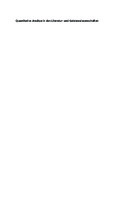Quantitative Ansätze in den Literatur- und Geisteswissenschaften
Systematische und historische Perspektiven
| dc.contributor.editor | Bernhart, Toni | |
| dc.contributor.editor | Willand, Marcus | |
| dc.contributor.editor | Richter, Sandra | |
| dc.date.accessioned | 2018-12-01 23:55:55 | |
| dc.date.accessioned | 2020-01-07 16:47:06 | |
| dc.date.accessioned | 2020-04-01T11:52:54Z | |
| dc.date.available | 2020-04-01T11:52:54Z | |
| dc.date.issued | 2018 | |
| dc.identifier | 1002585 | |
| dc.identifier | OCN: 1048178816 | en_US |
| dc.identifier.uri | http://library.oapen.org/handle/20.500.12657/27424 | |
| dc.description.abstract | Since the beginning of the 19th century, quantitative techniques have been used in literary and human sciences to describe, analyze and interpret texts. Such approaches were underrepresented until the end of the 20th century, but are becoming increasingly important in the digital humanities. The aim of the volume is to contextualize theories of theory, methodology and subject history on the one hand, and on the other hand to examine the significance of their results with a view to the digital present. In view of the innovative verve of digital humanities, it should not be forgotten that the idea of juxtaposing interpretive close reading with descriptive-analytical, remote reading is not much younger than the idea of close reading itself. Counting is by no means the first through the 'digital revolution' of the humanities. Rather, what has been determined by late Dilthey as the subject of the understanding and qualitatively oriented humanities has been declared 'measurable' for some 200 years. | |
| dc.language | German | |
| dc.subject.classification | thema EDItEUR::D Biography, Literature and Literary studies::D Biography, Literature and Literary studies::DS Literature: history and criticism | en_US |
| dc.subject.classification | thema EDItEUR::D Biography, Literature and Literary studies::DS Literature: history and criticism::DSA Literary theory | en_US |
| dc.subject.other | Literature | |
| dc.subject.other | history | |
| dc.title | Quantitative Ansätze in den Literatur- und Geisteswissenschaften | |
| dc.title.alternative | Systematische und historische Perspektiven | |
| dc.type | book | |
| oapen.abstract.otherlanguage | Seit Beginn des 19. Jahrhunderts werden in den Literatur- und Geisteswissenschaften quantitative Verfahren angewandt, um Texte zu beschreiben, zu analysieren und zu interpretieren. Bis zum Ende des 20. Jahrhunderts waren solche Ansätze unterrepräsentiert, gewinnen im Zuge der Digital Humanities jedoch sehr stark an Bedeutung. Ziel des Bandes ist es, quantifizierende Verfahren einerseits theorie-, methoden- und fachgeschichtlich zu kontextualisieren, andererseits aber auch mit Blick auf die digitale Gegenwart zu prüfen, welchen Stellenwert ihre Ergebnisse haben. Angesichts der innovativen Verve der Digital Humanities darf nicht vergessen werden, dass die Idee, einem interpretativen close reading ein (vermeintlich?) deskriptiv-analytisches distant reading gegenüberzustellen, nicht sehr viel jünger ist als die Idee des close reading selbst. Denn Zählen ist keinesfalls erst durch die 'digitale Revolution' der Geisteswissenschaften denkbar geworden. Vielmehr wird schon seit ungefähr 200 Jahren das, was vom späten Dilthey als Gegenstand der verstehenden und qualitativ orientierten Geisteswissenschaften bestimmt wurde, auch zum 'messbaren' Objekt erklärt. | |
| oapen.identifier.doi | 10.1515/9783110523300 | |
| oapen.relation.isPublishedBy | 2b386f62-fc18-4108-bcf1-ade3ed4cf2f3 | |
| oapen.relation.isbn | 9783110522006 | |
| oapen.pages | 396 | |
| oapen.place.publication | Berlin, Germany | |
| oapen.identifier.ocn | 1048178816 |

